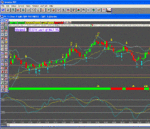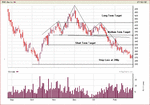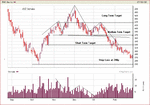Hi All,
I have never been able to interpret volume successfully. To the point where I do not use it these days. I read in the Feb SFO (an interesting read, by the way) that a spike accompanied by high volume was a good indication that the market was telling me to sell (it was a buying spike). I have taken advantage of the charts on this thread to look at the spikes. They all reversed with good selling opportunities but the volume on all the ones that I examined were low- some very low.
I have seen the market rising with high, medium and low volume.
Falling with high, medium and low volume.
Peaking and bottoming with high, medium and low volume.
Divergence does not help me, either. The market seems to peak in volume halfway up the rise. A student of volume theory could get a signal on the next peak with lower volume, only to see one or two more peaks with even lower volume before the reverse finally comes.
Any comments welcome, please.
Split
I have never been able to interpret volume successfully. To the point where I do not use it these days. I read in the Feb SFO (an interesting read, by the way) that a spike accompanied by high volume was a good indication that the market was telling me to sell (it was a buying spike). I have taken advantage of the charts on this thread to look at the spikes. They all reversed with good selling opportunities but the volume on all the ones that I examined were low- some very low.
I have seen the market rising with high, medium and low volume.
Falling with high, medium and low volume.
Peaking and bottoming with high, medium and low volume.
Divergence does not help me, either. The market seems to peak in volume halfway up the rise. A student of volume theory could get a signal on the next peak with lower volume, only to see one or two more peaks with even lower volume before the reverse finally comes.
Any comments welcome, please.
Split




